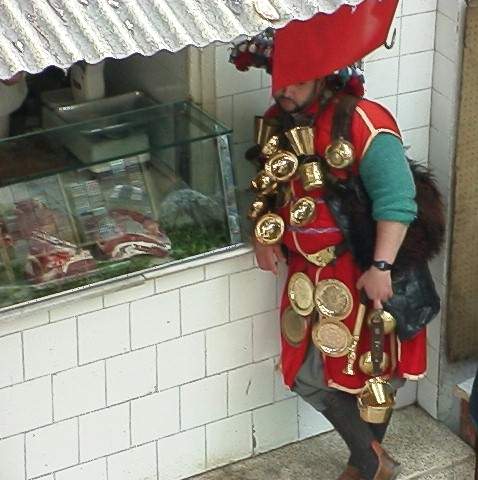
Around the World in 1998-1999; Morocco
Note; this post is recreated from the original wired2theworld website post with the dates below. The old posts were reformatted for the 20th anniversary of wired2theworld. As much as possible, the content is unchanged and unedited from the original, only some formatting, spelling, and link errors have been corrected.
Tangiers Morocco
Kristina’s Journal:
March 11, 1999
Morocco
US$1=9.46 Dirams
Maybe our first indication of a problem should have been way back in Algeciras when the travel agents were all surprised that we wanted more than just a day trip. Or maybe it was that they all used the same tour company, Transafric, so we had no choice of price or accommodation. But I think the real clue came this morning when we got to the Transafric office at the port and discovered that none of the other people going over with us were even spending the night in Morocco. Did they know something we did not?
The company was completely disorganized and we had to wait until 5 minutes before the ferry left to find out if we were on the fast hydrofoil, which was full, or on the slightly slower ferry. We were herded through immigration by someone from the company who told us nothing of what was going on. Somehow we wound up on the hydrofoil, which turned out to be a very small, seasick-inducing, fast boat. Nothing like the big hydrofoil we took from Hong Kong to Macau.
After we arrived, we were met by another guide, who took our vouchers and the passports of all the other one-day tour members. Us, he told to go through immigration to get our passports stamped, and then he walked away.
Our passports were stamped and we hurried after him to the bus. Our group was comprised of fourteen people, all English speaking except for two older German men. This meant that the Moroccan guide was forced to practice his horrible German on them and we were subjected to a terrible bilingual narration over the bus microphone.
Ok, so far, not really so bad. We got on the bus and we drove through the old colonial port area of the city. From there we went through all the different quarters of the city; Spanish, American, French, Jewish, while the guide repeatedly told us how religiously “tolerant” Morocco is as a Muslim country. Then we stopped at our first “tourist” photo-op so we can take pictures of the guide and so the lone souvenir vendor can make the first over-priced sale of many to the German tourists. Here we discover that all transactions can be made in Moroccan Dirams, Spanish Pesetas, US Dollars, even British Pounds; the vendor is a veritable international bank.
Our next photo-op comes on top of a mountain after we pass a long white wall, behind which we are told the King lives. At this stop are camels where you can sit for no longer than 30 seconds and have your picture taken (with your own camera) for one US dollar, 10 diram, or 100 pesetas. This, we decide to do, just for the hell of it. I figure this is a better place to have a picture taken with a camel than the Great Wall of China (see our post on the camels on the Great Wall of China); at least they come from here. After this, we had another brief stop at a look-out where we can see Gibraltar in the distance across the water.
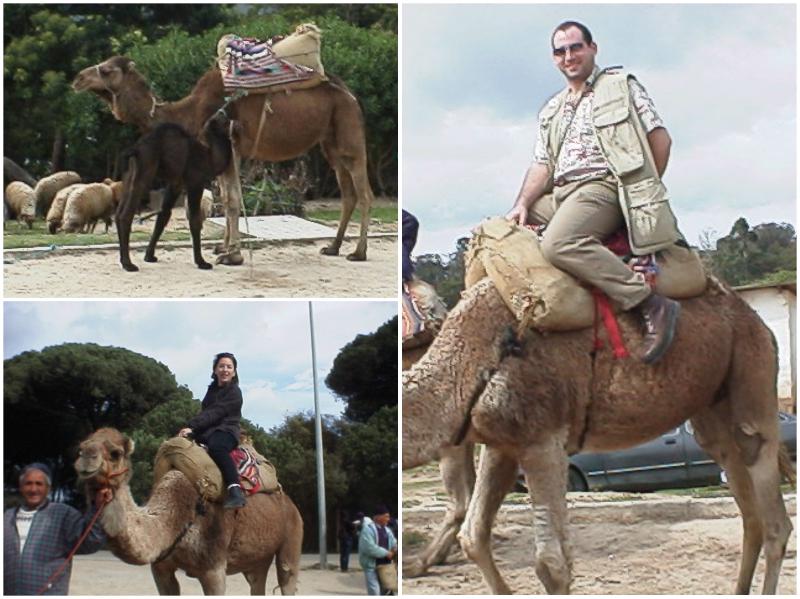
From here we drive back into the old city to the Casbah and the Medina. The Casbah is an old walled fortress built by the Portuguese five hundred years ago. We walk a bit inside the walled area where we just “happen upon” a snake charmer. One man plays music while the other takes a large cobra out of a box for 20 seconds so that people can take photos of it. The guide tells them we are in a hurry. They then put the cobra away and walk around asking people for money. After this, another snake comes out of the box to be draped over one of the German tourist’s shoulders for another photo and yet more money.
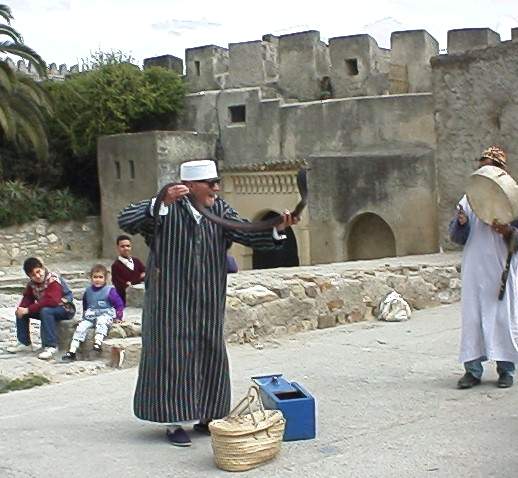
We then walk into the Medina which is the shopping area and oldest part of Tangiers. This is what I had come for; I wanted to see the maze of narrow streets lined with shops and homes. What we got instead was a whirlwind walking tour with no time to stop and look into the shops until we got to the Tourist Handicraft “Cooperative” store. This is where we sat down and got our instruction on what constitutes a good, hand-knotted rug. We were then given over half an hour to look at rugs and other handicrafts which we could purchase. To be fair, these were beautiful, high-quality rugs, but horribly expensive with the smallest (3×5) starting at about $300! I do think the prices included shipping and insurance (at least they did for the larger rugs) and I am sure they would have bartered on the price a bit. I still think most of the items were over-priced. I wanted a simple cotton caftan like both the women and the men wear here and it was $45! On the street, they were much, much, less. One of the Germans bought a small kilm rug.
After the cooperative, we went to lunch in a restaurant in the medina. This, I was excited about as well, remembering back to the few wonderful meals I have had in Moroccan restaurants in Los Angeles. Again, disappointment. Our first dish was a soup, very much like minestrone. OK. Then we had two tiny lamb kabobs with a spicy chili sauce. Not bad. Then, a very mediocre couscous with chicken. Followed up by a cookie and some very sweet, but traditional, mint tea. Fine, I guess I shouldn’t expect too much from tour food.
From lunch, we walked briefly through one of the food markets where hundreds of naked chickens hung from the rafters and mountains of olives waited. I wanted more time here, but this was not to be. We were rushed off to another cooperative, this time a “herbal pharmacy”. Here they sold herbal remedies and spices. I bought some lovely smelling orange blossom oil, supposedly for stress and motion sickness (I thought it might help with the ferry back), and some wonderful masala spice mix for lamb.

After this, it was back on the bus and back to the boat for the others in the group. But first, they dropped us at our “four-star beach hotel, the Solazur”. Yeah, right. We had been warned in the past that the star ratings of hotels in Morocco do not compare with the rest of the world and this is no understatement. As we walked up the front steps of the hotel, through the drifts of trash and garbage on the steps I had a horrible feeling of foreboding. We checked in and went up to our room. The only good thing I can say is that it has a nice view of the beach. Other than that, the hotel was obviously built in the early 1960’s and has not been renovated since.
So, here we sat, disappointed by the tour, by the hotel, and dejected at the thought of spending two more days in this place. We thought about going somewhere else tomorrow, and investigated it, but decided it would be just too much more money. At this point we decided to cut our losses and go back to Spain a day early, even forfeiting the extra day here which we have already paid for. This is not something I like to do, but one thing I have learned on this trip is not to stay where I am unhappy just because of money. Oh, and trust your gut feeling in the beginning (we should have known better and only come for the day).
But even arranging to leave was not easy. First, we looked at the ticket for the ferry back that we were given by the tour guide here in Morocco. It was dated for today, not two days from now as it should be! Problem number two, we had booked and paid for a hotel in Algecerias for when we returned. So we had to call the travel agent in Spain, twice, at a cost of 70D each call to change and reconfirm the hotel there and be reassured that we would be able to use the ticket we had to get back to Spain (I am still unconvinced it will work).
Tonight we are to have dinner in the hotel, as it is covered by the package. Unfortunately, after looking at the menu, I don’t think I’m going to get my good Moroccan meal here either. Not with the choice of either meatballs or fish.
March 12, 1999
Ok, well, dinner wasn’t all that bad considering that it was served in a hotel dining room intended for 300+ people and there were only about 12 in the entire place. They actually had a very nice assortment of cold salads, a soup, and a couple of hot entrees. The fish wasn’t all that bad.
The next morning, we went to check out and the man at the front desk, said “You’re leaving today?” We replied yes, and waited to be told of our phone bill. He said, all was fine, didn’t tell us we owed anything, so we left, with no paperwork, no receipt. We figured that since they were getting an extra night paid from us, food included, they could foot the bill for the phone call and we said nothing.
Off we went, walking toward the Medina to do a little shopping before we were supposed to catch the ferry back in a few hours. My goal was to buy a djalaba, which is part of the traditional clothes both men and women wear in many muslim countries.
Here in Morocco, most of the women do not wear a veil, and nor do they wear all black as in many other Islamic countries. Here, they wear brightly colored djellabas over another outfit, usually pants, underneath. A djellaba is an ankle-length garment that slips over the head, covering the entire body. It always has a pointed hood that usually just hangs down the back, not worn. They are usually a solid color, sometimes striped, and are often made of silk or other fine fabric. Only about 30% of the women we saw wore a head covering and a veil. Men tended to wear the djellaba as well, usually in white, gray, or brown, often of a thicker material. The day before, while on the “forced shopping tour from hell” I had seen a beautiful, bright blue cotton caftan (similar to the djellaba, but without the hood) and I was determined to find another, at a better price.
As we walked into the Medina, we suddenly found ourselves attached to a wanna-be guide, who peppered us with questions about what we wanted. First, we tried to get rid of him, saying that we didn’t want a guide, and he told us, “I show you my Uncle’s store, just for friendship. No obligation, if you like, you buy” As soon as he figured out what we were looking for, he led us on an hour and a half long search for the perfect, and nonexistent djellaba.
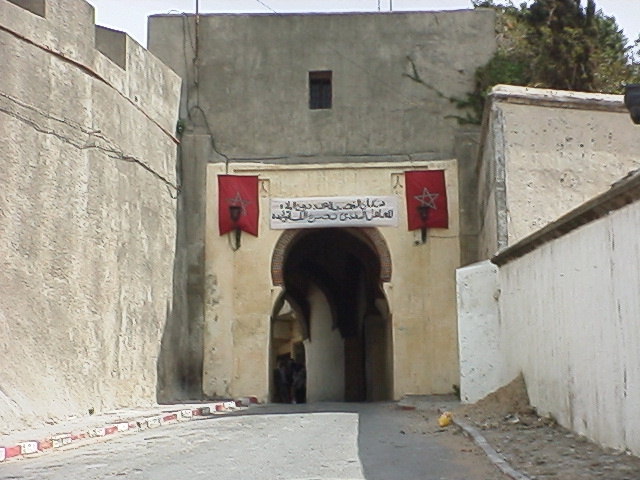
Store after store, I was told that what I want was not made, not possible, did not exist! Then I was repeatedly shown things I did not want, for they were just not listening. I would say very specifically, “I want lightweight cotton, dark color, long sleeves, no decoration” and I would be shown something out of polyester, with short sleeves, bright pink, with sequins! AAACK! Every once in a while I would see something I liked, but of course, it would be made of silk, and cost $75 or something. I would then tell them, it was too expensive, and that I only wanted to spend $20 or so. They would then pretend to be shocked and offended that I would “offer so little for such a fine garment”. I would then patiently explain that, yes, it was a fine garment, no argument there, but I just could not afford it, nor did I want it no matter the cost!
Shop after shop, I was beginning to feel like one of my favorite Dr. Suess books, Old Hat, New Hat. Everything I looked at was too bright, too heavy, too light, too expensive, too cheap, just not right! After a while, I just got frustrated and did not want to look at another shop “for luck” as our “guide” said.
Finally, we just told him thank you, and that we were going to be on our way and have some lunch. He then did the absolutely wrong thing, he asked us for a tip! By now, my nerves were completely frayed, I was tired of him following us around, and I’m afraid I unleashed a bit of my frustration upon him. “What about friendship”, I said? “What happened to “no money, just look?” I was furious! Finally, he backed off, and then found us five minutes later and apologized.
At this point, we found our way through the labyrinth of alleyways and back to the main street. We walked through the food market, bought some wonderful garlic and chili green olives and decided to go somewhere and have lunch. On the way back down the main street toward the port, we stopped in one last shop, one that we had been in earlier. By then, I thought I would just buy an inexpensive, lightweight, white cotton caftan to wear in the summer around the house, which is what I had wanted it for anyway. Anyway, after much hard bargaining, I finally settled on a medium weight gray and black striped djalaba that had almost no decoration, but that had obviously been handmade judging by the small, hand-done stitches, for $25 cold, hard US$ cash. I probably still paid too much, but since the price started at $80, I think I got an ok deal.
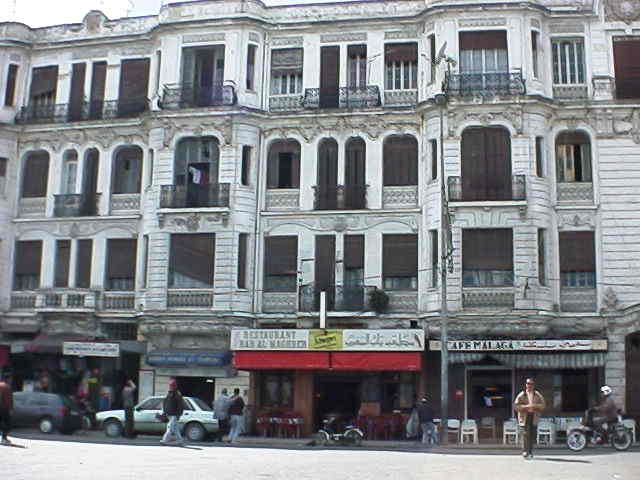
We had a great tasting simple lunch at a sidewalk cafe overlooking the main square near the port. I noticed that although there were many women walking in the streets, alone and in groups, there were never any in the cafes. When I went inside the cafe to use the restroom, which was in the back up a flight of stairs, I have to admit that I was glad I was wearing long pants and a long sleeve shirt. The looks I received from the men in the restaurant, even though I was not scantily dressed made me want to put on my djellaba then and there. Back outside though, sitting at our table, I felt fine watching life go by. By the time our food came, I was glad we were there for lunch; we both had excellent beef kabobs (much better than the day before), marinated in those wonderful Moroccan spices, french fries, drinks for under US$7.
Helpful Guidebooks for Morocco:
Have you been to Morocco? Thinking of going?
Leave me a comment below and make my day!
You can also find our other travels within Morocco here.
Any post on this site may contain affiliate links. Thank you for supporting wired2theworld by using our links to shop, book hotels, or organize tours. If you use them, they cost you nothing extra but we may make a small commission that helps us to continue to provide helpful and free content.

